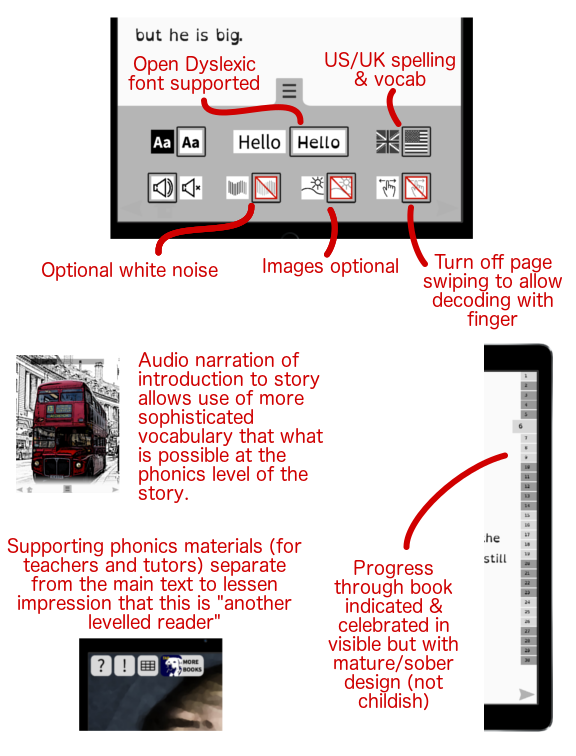When we submitted our first app for App Store Review (a necessary part of the process of selling apps on the App Store), it was initially rejected because, at least on the surface, it appeared to be “primarily a book”. We were encouraged to package the content as an eBook and distribute it through Apple’s iBook storefront. We would like to share the text and infographic of the appeal we immediately sent to Apple and which convinced them overnight that Bad was more than just a book. This allowed us to release this first decodable book app today. After you’ve read it, we’d love to hear from you. Are you convinced?
This appeal essentially points out the design choices made to support TAP series philosophy. The appeal begins below and continues to the end of this post:
… This app is not primarily a book of any sort that could be distributed through iBooks. This app is designed to deliver a dignified, confidence-building book-like experience to a very specific and under-served group of learners, namely teens and adults with severe dyslexia, ASD and ADHD. The functionality of the app supports this experience and is simply not available in iBooks. For that matter, most of these features are not available in ANY phonics app currently available on the App Store.
UNIQUE SETTINGS
- allow user to reduce distractions and unwanted changes in the app state:
- images OPTIONAL
- sound effects OPTIONAL
- swipe to turn OPTIONAL, allowing user to move fingers along the text (helps with decoding)
- allow masking of environmental distractions with OPTIONAL white noise
- support for Open Dyslexic, a font which some dyslexic learners find helpful
- progress indicated in a way that is encouraging without being patronizing or condescending
UK or US
The older learners for whom this app is intended typically have a well developed vocabulary and considerable life experience. We want to provide a text that maps as closely as possible onto that language and experience to avoid confusion and keep the focus on decoding. To this end, we allow the user to choose between UK and US spelling and vocabulary. The effect is subtle but important. For example, the words “mum” and “mom” refer to the same person but decode (sound-out) completely differently; after doing the work to decode the word, we want the user to end up with something familiar.
AUDIO WHERE NEEDED
The text content of the app is meant to be both fully decodable at the specified phonics level AND interesting to older readers. The story involves sophisticated themes, but at low phonics levels, we can’t use the terms that most accurately apply to these themes. To get around this constraint and to guide the reader in their understanding of the story, we made “page 1” an audio introduction. The rest of the text, however, is NOT available as audio, as its primary purpose is to provide decoding practice. This isn’t an audiobook.
DISCREET LEVELS AND PEDAGOGICAL SUPPORT
Consider also the design of the app, which is meant to minimize the impression that the user is looking at a levelled reader. Any information related to the phonics content of the book is kept out of the book itself rather than being included in an appendix, for example, which would confuse the reader and deny them the satisfaction of “getting to the end”. This information is accessible separately from the home screen, a separation of content which is not supported in an iBook.
[The image at the top of this post was attached to the appeal to illustrate these points.]
CONCLUSION
There are MANY “interactive book” apps available on the App Store. The functionality that differentiates them from “a mere book” is most often the addition of animation, a soundtrack or effects. For severely challenged teens and adults, these features would make the app impossibly distracting and useless in supporting their efforts to learn to read, efforts that have often been frustrated by years of instruction and materials poorly adapted to their needs.
Our app has a great deal more functionality that a conventional eBook, but that functionality is designed to REMOVE distractions rather than provide them while at the same time giving these learners the satisfaction of interacting with an app. They control the experience.
I hope the App Review Board will see how this app offers important functionality not found or supported in iBook to provide a positive book-like experience for older emergent readers, in particular those severely challenged by dyslexia, ASD and ADHD. This app belongs on the App Store and the binary should be accepted as is. Thank-you for your consideration.
